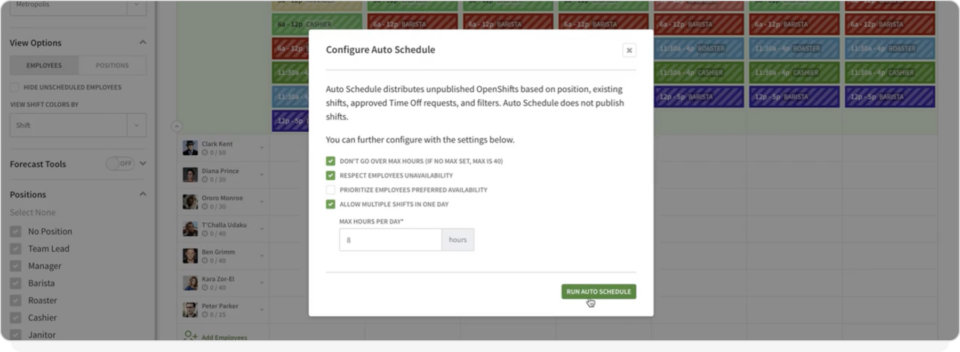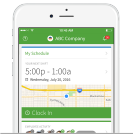What Is Predictive Scheduling? A Manager’s Guide
Try When I Work for free
To better protect employees, many cities and states are now considering or enacting a new type of scheduling law: predictive scheduling. We’ve put together a quick guide on everything you need to know about predictive scheduling laws, and how to get your business ready for the change.
Key takeaways
- Predictive scheduling promotes fairness and stability, helping employees plan their lives in advance and giving them better work-life balance
- Predictive scheduling laws vary by city and state, so knowing what laws govern your particular area is important
- Being prepared is the key to complying with these laws, as they can be complex and have many different aspects, including good faith estimates, fines for not releasing the schedule so many days in advance, mandatory rest periods, and more
- Penalties for non-compliance can be significant, including having to pay your employees for making last minute changes, or fines to your locality for not complying
- You can handle predictive scheduling laws much more effectively with employee scheduling software, like When I Work
Make predictive scheduling compliance easier than ever and save time each week building the schedule. Ready to get started? Sign up now for your free trial of When I Work.
What is predictive scheduling?
Predictive scheduling is giving out employee schedules ahead of time. It counteracts on-call and “just-in-time” scheduling practices that can hurt employees. This includes posting and changing schedules without advance notice or scheduling back-to-back closing and opening shifts.
There’s a reason why predictive scheduling laws are also referred to as “fair scheduling laws.” A majority of workers who experience unstable scheduling report that it interferes with their ability to provide for their families financially and emotionally. They can’t predict their day-to-day routines or their paychecks—a perfect recipe for high employee disengagement and turnover.

What are the predictive scheduling laws?
With more and more states enacting scheduling laws, mandatory predictive scheduling is a “when” not an “if” for business owners. Depending on where your business is located and how many employees you have, you may already or soon be required to participate in predictive scheduling.
Predictive scheduling laws require employers to post work schedules a certain amount of days or weeks before shifts begin and observe employee rest periods between shifts. They also discourage employers from changing schedules by requiring them to give employees more pay or giving employees the right to refuse to come in when they aren’t scheduled to work.
Handing out and sticking to a work schedule may not seem like a big deal. But if your business is based in these cities or states and you don’t fulfill your predictive scheduling requirements, you could receive a hefty fine.
Where is predictive scheduling mandated?
Berkeley, CA
Businesses affected: Employers in the building services, healthcare, hotel, manufacturing, retail, and warehousing industries with 56 or more employees globally. Employers in the restaurant industry with 10 or more employees in the city and 100 or more employees globally. Retail or restaurant franchises with 10 or more employees in the city and franchisees employing 100 or more globally. Not-for-profit corporations with 100 or more employees globally.
Emeryville, CA
Businesses affected: Retail employers with 56 or more employees globally and fast food businesses with 56 or more globally and 20 or more employees in Emeryville.
Los Angeles, CA
Businesses affected: Retail employers with at least 300 employees worldwide, including franchises.
San Francisco, CA
Businesses affected: “Formula retail establishments” with at least 40 stores worldwide.
Chicago, IL
Businesses affected: Businesses with more than 100 or more employees, nonprofits with more than 250 employees, and restaurants with at least 30 locations and 250 employees globally.
Evanston, IL
Businesses affected: Hospitality, retail, warehousing, manufacturing, and building services employers with 100 or more employees. Food service and restaurants with at least 30 locations and 200 employees globally. Franchisees in the covered industries with fewer than 100 employees that have franchisors with more than 30 locations globally.
New York, NY
Businesses affected: Fast food employers and retail businesses with more than 30 establishments nationally and retail employers with 20 or more employees.
Oregon
Businesses affected: Employers in retail, hospitality, or food services industries that have at least 500 employees.
Philadelphia, PA
Businesses affected: Employers in retail, hospitality, or food services industries that have at least 250 employees and 30 locations worldwide.
Seattle, WA
Businesses affected: Retail and food service establishments with more than 500 employees worldwide and full-service restaurants with more than 500 employees and more than 40 full-service restaurant locations worldwide.
Washington, DC
Businesses affected: All employers in the District of Columbia except for the U.S. federal government.
Related read: 10 Resources To Track Labor Laws In Your State
FAQ’s about predictive scheduling
We’re here to answer some of the most common questions about the laws of predictive scheduling that we’ve seen.
Are you required to post work schedules?
Absolutely. Predictive scheduling laws were created to help employees know when and how many hours they’ll be working ahead of time. You can share work schedules with employees in person or electronically. Just make sure they can also electronically access their schedule at work through scheduling apps or other means.
Start your free 14-day trial of When I Work! Click here to start scheduling your employees today.

How far in advance do you have to share employee schedules?
The key to predictive scheduling is advanced notice. Work schedules must be given to employees days or weeks before their shifts begin. How many days in advance varies by city or state, so check your local laws to be sure you’re in compliance.
While creating schedules weeks in advance might feel daunting, it doesn’t have to mean extra work. If you already know your employees’ availability, predictive scheduling makes it much easier to plan work around upcoming vacations, time off, or busy seasons. You can find out which employees are comfortable taking on extra shifts, and who might need a better work-life balance.
When you use software like When I Work, all of that information is already in the system, so building your schedule is fast and easy. You’ll have plenty of time to create the schedule in advance.
What if you have to change the schedule?
Once schedules are posted, even making small changes can have big implications. Seattle and Oregon’s predictive scheduling laws require employers to pay additional compensation if they add to or reduce hours from an employee’s schedule after sharing it. For example, employers in Oregon have to pay employees for half of the hours not worked if they schedule a shift and then cancel it—and have to give employees one additional hour of pay when hours are added without notice.
When I Work makes it easy to build the schedule weeks in advance. Even if you’re not ready to publish it, you can still work on it with enough time to get it just right so you don’t have to make changes after it’s published. That way you can be sure you’re always in compliance with your local laws and can avoid the fines and penalties that come with late changes.
What about closing and opening shifts?
No more “clopening. Under predictive scheduling laws, employees have to take mandated rest periods between their shifts. That means employers can’t make employees work closing and opening shifts less than 10 hours apart unless their employees specifically request or agree to work. If employees do agree to “clopen” or work during their required rest period, employers may have to pay time-and-a-half for the hours.
Can you fire employees for not coming in on days off?
Again, no. Requiring employees to come in when they’re not scheduled to work falls under the same guidelines as unplanned schedule changes. If you ask employees to come in and they agree to work on their day off, expect to pay a similar premium.
What about new employees?
“Good faith estimates” are another important part of predictive scheduling. When you hire a new employee, you should provide them with a written “good faith estimate” of how many hours they can expect to work. Some states require you to write estimates for current employees and revise them annually based on changes to employees’ availability.
Current employees also have first call on extra hours. Instead of hiring new employees to work, extra shifts have to be offered to existing employees first. This gives current employees the chance to move from part-time to full-time work or accept more hours when they need them.
What can you do now to prepare for predictive scheduling laws?
Switching from on-call to predictive scheduling is a big adjustment for everyone involved. The sooner you give it a try with your team, the sooner you’ll find out what works for you. Ease your business into the transition by incorporating these predictive scheduling requirements along the way:
Check in on availability
Touch base with everyone to make sure their available hours are still accurate. Use this as an opportunity to get employees’ feedback about their current schedules.
Cut down on “clopening” shifts
Give your employees a break from back-to-back shifts and try observing a 10-hour rest period. You may find that more hours between shifts actually equals more productivity (and more engaged employees).
Post schedules early
Try posting schedules a week earlier, especially if most of your staff are on-call. This trial run will show you the amount of time and resources you’ll need to fulfill predictive scheduling requirements. It will also give you a chance to try out different scheduling software and solutions.
Find volunteers
Instead of mandating employees come into work on their days off, put together a volunteer on-call list. Employees can sign up for extra hours and give specifics around availability so you know who can fill last-minute shifts.
Predictive scheduling made easier with When I Work
Remember the goal of predictive scheduling is to create fair scheduling practices. Changing from on-call scheduling to predictive scheduling will take some getting used to. Ultimately, it will also help build a better work environment for everyone on your team.






